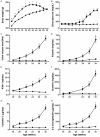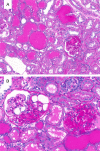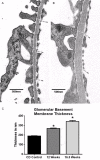The ZDSD rat: a novel model of diabetic nephropathy
- PMID: 28979697
- PMCID: PMC5622266
The ZDSD rat: a novel model of diabetic nephropathy
Abstract
The ZDSD rat is a new obese-diabetic rat model that expresses type 2 diabetes in the presence of an intact leptin pathway. During a long pre-diabetic state, the animals exhibit most of the features of metabolic syndrome including obesity, hyperlipidemia, hypertension, insulin resistance and decreased glucose disposal. The animals used in these studies were either allowed to become spontaneously diabetic at 16-30 weeks of age, or diabetes was induced with a diabetogenic diet. In the presence of either spontaneous or diet-induced diabetes, they develop progressive albuminuria as well as increases in other urinary markers of impaired renal function (kidney injury molecule-1 (KIM-1), β2-microglobulin, clusterin and cystatin C). Typical morphological changes of nephropathy, such as glomerular capillary basement membrane thickening and podocyte effacement, accompany these marker increases. Lisinopril (ACEi) treatment (30 mg/kg/day via the diet) dramatically reduced diabetes-induced albuminuria by 85%, independent of the duration of diabetes or the initial albumin excretion. These results position the ZDSD rat as a relevant model of diabetic nephropathy that can be treated with clinically effective compounds.
Keywords: Diabetes; kidney; nephropathy; rat; renal.
Conflict of interest statement
The ZDSD rat was developed, in part, from the ZDF rat and as such RGP receives a small portion of license fees that are paid to Indiana University for sales of the ZDSD rat, he is also a consultant with Crown Bioscience, the distributor of the ZDSD rat. CVJ is an employee and KMZ is a consultant with Crown Bioscience.
Figures




References
-
- Gugliucci A. Glycation as the glucose link to diabetic complications. J Am Osteopath Assoc. 2000;100:621–634. - PubMed
-
- Ospina NS, Montori VM. Review: in type 2 diabetes, GLP-1 agonists plus basal insulin reduce HbA1c without increasing hypoglycemia. Ann Intern Med. 2015;162:JC6. - PubMed
-
- Aronson D. Hyperglycemia and the pathobiology of diabetic complications. Adv Cardiol. 2008;45:1–16. - PubMed
-
- John S. Complication in diabetic nephropathy. Diabetes Metab Syndr. 2016;10:247–249. - PubMed
LinkOut - more resources
Full Text Sources
